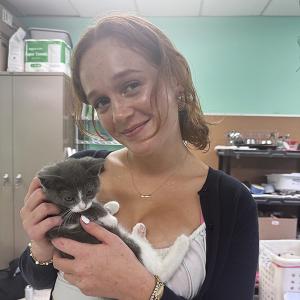Oberlin Blogs
The Big Parade Blog
May 23, 2011
Tess Yanisch ’13
When I was a prospective student, I read the online edition of The Oberlin Review before visiting. One of the lead articles was about preparations for something called "The Big Parade." It discussed where and when float building was, but the article seemed to take for granted that the reader knew what the Big Parade was. I didn't know. It was a parade, clearly, but who ran it? Was it some kind of a fundraiser?
My process of discovery took quite a while--nearly two years. I didn't go last year, because I somehow managed to miss learning when it was. (This doesn't seem to be a huge loss, however; apparently it was cold and rainy.) I picked up enough to infer that it wasn't any kind of college- or cause-sponsored event, but I still knew very little.
This year, however--the tenth year of the tradition--I had friends in the parade and I was determined to go.
The parade left Eastwood Elementary at noon on Saturday. The weather that day was gorgeous, one of the first real summery days of the year. I went to lunch at around 11:45, scarfed down a bagel, and left with a friend. The south side of Tappan Square was lined with people, as were the next few blocks of West College Street. There were people of all different ages, including very adorable small children. (One thing you miss at college is interacting with people who aren't either 18-23 or professors.) We moseyed down the parade route toward Eastwood and met it head-on.
There were a lot of groups represented there. The Rotary Club was there, as were the Girl Scouts, tossing candy to the crowd. A marching band went by. The co-op organization, OSCA, was there was well, represented by a small group dragging a statue of a llama on a platform. The llama is an OSCA symbol, because when you raise your hand to make a proposal, your hand is llama-shaped (middle two fingers touching thumb, index and pinkie fingers sticking up). No one knows why this is.
OSteel, the steel drum band, marched by. America Reads had a float with a giant Cat in the Hat. WOBC, the Oberlin College and Community radio station, had a miniature radio tower on wheels that just barely passed underneath the traffic lights. Some people who looked like they were wearing ostrich costumes darted by. Circus stilters walked by, including Connor on his bouncy stilts (well, he hopped, rather than walked).
Then, in the distance, we caught sight of sails. A square-rigged pirate ship rolled majestically into view. I can't remember quite how it worked, but I think it was pulled by a large team of people. I know that it was crewed by two little boys, probably seven years old, both waving wooden swords. There was a wheel--which appeared to be appropriated from a bike, with little handgrips added on--on the back. True ingenuity.
A very ornate float came next, covered in brightly-colored drapes pulled by more people, all of whom were singing. Now and then they would pause to scatter vegan cookies in plastic bags. The back of their float said "Hare Krishna." All I know about the Hare Krishnas is that they would give people flowers in airports back when you could go further than ten feet into an airport without a boarding pass, and even that is secondhand knowledge. But apparently Oberlin has quite a few of them.
After them--or maybe before them, I'm not quite sure of the order--was the Oberlin Taiko float. Taiko is an ancient Japanese drumming style. However, it's not like OSteel; it's very much not a kind of drum that you can play while marching. Fortunately, people in ancient Japan realized this too and solved the problem. There's a style of playing in which you hold the drum between your legs and play from a sit-up position. I have a friend in the group who told me all about this: during festivals, people would be hidden from view in the float and play for hours. The only problem with this is that it's apparently excruciatingly painful if you haven't been doing it for years (hitting things while doing crunches sure sounds exhausting to me).
How it actually worked was this: their float was a few pieces of wood (thick plywood or something slightly sturdier) on wheels, pushed by two people. Two people were standing on the float, playing on the bar that was used to push it (or something; memory fails me). Two were sitting and playing "properly." They rotated through fairly frequently.
After them came a person with overalls and a broad-brimmed hat carrying an enormous fishing pole. On the end of its string was a three-foot-long worm. Following it intently was an enormous fish. I saw at least three pairs of legs, which should give you a feel for the scale of it. I got a look at the structure later, lying abandoned on Tappan Square. It was a clever use of materials: the body was made of the kind of fabric that tents are made of, wrapped around hula hoops or something. White and black paper plates made its scales; chicken wire wrapped around its tail for texture and to hold the shape.
The fish was immediately followed by three people on bikes with some crazy apparatus attached. They had wings on their backs and some wire connected the wings to the bikes, making them flap as they pedaled. And they were followed by a dragon.
This dragon's skeleton consisted of a simple framework that could have been a modified clothes rack: a pole running between sets of wheels with a box overhead. It was towed by a pull-bar on the front, I think. Its body was made up of metal rings covered in some diaphanous cloth. To the front was a several-jointed neck and a head with a jaw that opened and closed. It had wings on its sides that were hoisted up and down by people with sticks and feet that moved as it rolled. It was a marvelous piece of work. At the end of the parade, when all the floats came to a stop, it loomed over the Taiko float.
A car with a sign that said "Libertarians" brought up the end. For some reason I don't believe I can properly define, it seemed fitting that the libertarians would be represented by an old car with a growly engine.
After the parade, I watched OSteel jam with Taiko until Connor asked me to help him carry stilts into Tappan Square. There, he helped people learn how to use them. I only attempted peg stilts (the kind where you hold onto a long piece of wood and stand on a small block attached to that long piece), but others tried the kind that you tie onto your feet and some people even attempted the bouncy ones. I did okay on the stilts after a while. The trick is to move when you feel yourself losing balance, not to stop and try to get upright again. Also, don't let your feet get too far apart--small steps are best at first. Hobbling like an old lady is a good way to begin.
I wandered around looking at all the goings-on. An inflatable moon-bounce occupied one patch of grass, with a line of small children and college students outside it. There was free food everywhere: in addition to an enormous grill, there was a stir-fry that the Hare Krishnas were giving away. I met my adviser and two of her sons, who released homing doves in the center of Tappan Square.
The Folk Festival was also happening that day, so I walked over to the bandstand and listened to the people playing there for a while. I also encountered a group of people in a different part of Tappan, playing amazing-looking instruments--like drums with bows attached. I approached them after they finished a song and asked the name of the instrument. It is the berimbau. It comes from Brazil.
While we were messing around with stilts, one of my friends commented that "It's almost the Oberlin we signed up for." I don't know quite what he meant by that, but it certainly came near my idyllic notions of what college would be like. It was one of the most fun and simultaneously one of the most relaxing afternoons I'd had in a long time.
Tags:
Similar Blog Entries
Birthdays at Oberlin
April 9, 2025
Here are some fun things we’ve done on my and others' birthdays to make the day special!


